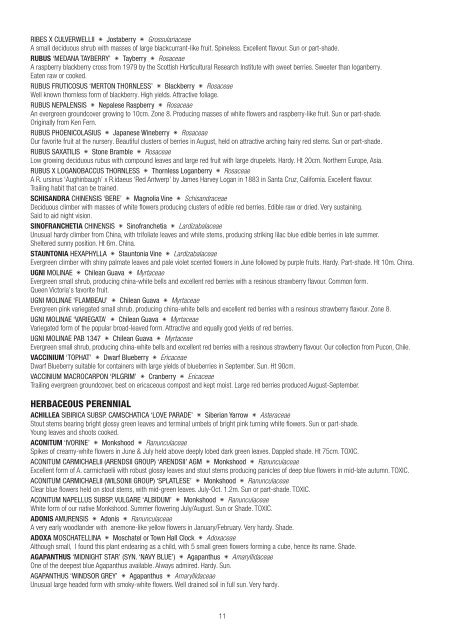2012/13 Catalogue - Edulis Nursery
2012/13 Catalogue - Edulis Nursery
2012/13 Catalogue - Edulis Nursery
Create successful ePaper yourself
Turn your PDF publications into a flip-book with our unique Google optimized e-Paper software.
RIBES X CULVERWELLII · Jostaberry · Grossulariaceae<br />
A small deciduous shrub with masses of large blackcurrant-like fruit. Spineless. Excellent flavour. Sun or part-shade.<br />
RUBUS ‘MEDANA TAYBERRY’ · Tayberry · Rosaceae<br />
A raspberry blackberry cross from 1979 by the Scottish Horticultural Research Institute with sweet berries. Sweeter than loganberry.<br />
Eaten raw or cooked.<br />
RUBUS FRUTICOSUS ‘MERTON THORNLESS’ · Blackberry · Rosaceae<br />
Well known thornless form of blackberry. High yields. Attractive foliage.<br />
RUBUS NEPALENSIS · Nepalese Raspberry · Rosaceae<br />
An evergreen groundcover growing to 10cm. Zone 8. Producing masses of white flowers and raspberry-like fruit. Sun or part-shade.<br />
Originally from Ken Fern.<br />
RUBUS PHOENICOLASIUS · Japanese Wineberry · Rosaceae<br />
Our favorite fruit at the nursery. Beautiful clusters of berries in August, held on attractive arching hairy red stems. Sun or part-shade.<br />
RUBUS SAXATILIS · Stone Bramble · Rosaceae<br />
Low growing deciduous rubus with compound leaves and large red fruit with large drupelets. Hardy. Ht 20cm. Northern Europe, Asia.<br />
RUBUS X LOGANOBACCUS THORNLESS · Thornless Loganberry · Rosaceae<br />
A R. ursinus ‘Aughinbaugh’ x R.idaeus ‘Red Antwerp’ by James Harvey Logan in 1883 in Santa Cruz, California. Excellent flavour.<br />
Trailing habit that can be trained.<br />
SCHISANDRA CHINENSIS ‘BERE’ · Magnolia Vine · Schisandraceae<br />
Deciduous climber with masses of white flowers producing clusters of edible red berries. Edible raw or dried. Very sustaining.<br />
Said to aid night vision.<br />
SINOFRANCHETIA CHINENSIS · Sinofranchetia · Lardizabalaceae<br />
Unusual hardy climber from China, with trifoliate leaves and white stems, producing striking lilac blue edible berries in late summer.<br />
Sheltered sunny position. Ht 6m. China.<br />
STAUNTONIA HEXAPHYLLA · Stauntonia Vine · Lardizabalaceae<br />
Evergreen climber with shiny palmate leaves and pale violet scented flowers in June followed by purple fruits. Hardy. Part-shade. Ht 10m. China.<br />
UGNI MOLINAE · Chilean Guava · Myrtaceae<br />
Evergreen small shrub, producing china-white bells and excellent red berries with a resinous strawberry flavour. Common form.<br />
Queen Victoria’s favorite fruit.<br />
UGNI MOLINAE ‘FLAMBEAU’ · Chilean Guava · Myrtaceae<br />
Evergreen pink variegated small shrub, producing china-white bells and excellent red berries with a resinous strawberry flavour. Zone 8.<br />
UGNI MOLINAE ‘VARIEGATA’ · Chilean Guava · Myrtaceae<br />
Variegated form of the popular broad-leaved form. Attractive and equally good yields of red berries.<br />
UGNI MOLINAE PAB <strong>13</strong>47 · Chilean Guava · Myrtaceae<br />
Evergreen small shrub, producing china-white bells and excellent red berries with a resinous strawberry flavour. Our collection from Pucon, Chile.<br />
VACCINIUM ‘TOPHAT’ · Dwarf Blueberry · Ericaceae<br />
Dwarf Blueberry suitable for containers with large yields of blueberries in September. Sun. Ht 90cm.<br />
VACCINIUM MACROCARPON ‘PILGRIM’ · Cranberry · Ericaceae<br />
Trailing evergreen groundcover, best on ericaceous compost and kept moist. Large red berries produced August-September.<br />
HERBACEOUS PERENNIAL<br />
ACHILLEA SIBIRICA SUBSP. CAMSCHATICA ‘LOVE PARADE’ · Siberian Yarrow · Asteraceae<br />
Stout stems bearing bright glossy green leaves and terminal umbels of bright pink turning white flowers. Sun or part-shade.<br />
Young leaves and shoots cooked.<br />
ACONITUM ‘IVORINE’ · Monkshood · Ranunculaceae<br />
Spikes of creamy-white flowers in June & July held above deeply lobed dark green leaves. Dappled shade. Ht 75cm. TOXIC.<br />
ACONITUM CARMICHAELII (ARENDSII GROUP) ‘ARENDSII’ AGM · Monkshood · Ranunculaceae<br />
Excellent form of A. carmichaelii with robust glossy leaves and stout stems producing panicles of deep blue flowers in mid-late autumn. TOXIC.<br />
ACONITUM CARMICHAELII (WILSONII GROUP) ‘SPLATLESE’ · Monkshood · Ranunculaceae<br />
Clear blue flowers held on stout stems, with mid-green leaves. July-Oct. 1.2m. Sun or part-shade. TOXIC.<br />
ACONITUM NAPELLUS SUBSP. VULGARE ‘ALBIDUM’ · Monkshood · Ranunculaceae<br />
White form of our native Monkshood. Summer flowering July/August. Sun or Shade. TOXIC.<br />
ADONIS AMURENSIS · Adonis · Ranunculaceae<br />
A very early woodlander with anemone-like yellow flowers in January/February. Very hardy. Shade.<br />
ADOXA MOSCHATELLINA · Moschatel or Town Hall Clock · Adoxaceae<br />
Although small, I found this plant endearing as a child, with 5 small green flowers forming a cube, hence its name. Shade.<br />
AGAPANTHUS ‘MIDNIGHT STAR’ (SYN. ‘NAVY BLUE’) · Agapanthus · Amaryllidaceae<br />
One of the deepest blue Agapanthus available. Always admired. Hardy. Sun.<br />
AGAPANTHUS ‘WINDSOR GREY’ · Agapanthus · Amaryllidaceae<br />
Unusual large headed form with smoky-white flowers. Well drained soil in full sun. Very hardy.<br />
11


